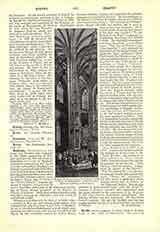

Krafft, ADAM, sculptor, b. about 1440 at Nuremberg; d. January, 1509, at Schwabach. He carved at Nuremberg the last famous Gothic monuments in stone. The earliest of his extant works are the so-called “Seven Falls of Christ”, that is to say Stations of the Cross representing Christ tottering and falling under the weight of His Cross, as well as the descent from the Cross. They were completed about 1490, and are now in the Germanic Museum at Nuremberg. The memorial bronze monument over the Schreyer and Landauer tomb in the church of St. Sebaldus was completed in 1492; three of its reliefs, highly colored, represent Christ carrying the Cross, His burial and resurrection, with a landscape for background. Later, Krafft undertook, at the request of Imhoff, the famous marble tabernacle in the church of St. Laurence. Decorated with tall slender turrets, a canopy, carved figures, and finely chiselled ornaments; it tapers gradually to its summit. Four bases and three carved figures, of the master and his two apprentices, support the pedestal, above which rises the rectangular tabernacle, richly decorated with delicate reliefs and with the figures of angels and saints in the numerous surrounding niches. It is universally admired as one of the most beautiful creations of Gothic art, and legend relates that the stone softened at the touch of Krafft’s chisel, to harden again in the new form which he imparted to it. Among the master’s works are also three handsome sepulchral monuments with statues of the Madonna, besides an “Entombment of Christ” and “Christ on Mount Olivet“. Krafft’s technical skill is amazing. His scenes from the Passion show deep feeling; his portrayal of saints is noble and full of expression, though his executioners are vulgar and repulsive. Gothic idealism seems to merge into a native realism; not Italian beauty of form, but native German strength, simplicity, and piety give value to his art.
G. GIETMANN

